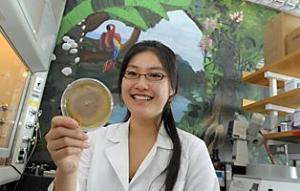A group of Yale undergraduates have discovered dozens of potentially beneficial bioactive microorganisms within plants they collected in the Amazon rain forest, including several so genetically distinct that they may be the first members of new taxonomical genera.
The analysis of 135 endophytes - fungal and bacterial microorganisms living within the inner tissue of plants - by members of the Rain Forest Expedition and Laboratory course at Yale will be published August 25 in the journal
PLoS One.

|
| ©Yale University
|
| Yale undergraduate Sun Jin Lee discovered that an extract from a second fungal endophtye reduces inflammation in human tissue. A subsequent analysis of the molecule revealed it to be an inhibitor of apoptosis, or programmed cell death.
|
The endophytes were collected during a 2007 trip to Peru organized by Scott Strobel, chair of the Department of Molecular Biophysics and Biochemistry at Yale, with a grant from the Howard Hughes Medical Institute.
The ability of 15 untrained students to find and culture such a novel collection of organisms, many of which are biologically active, illustrates the vast scientific potential of tropical areas, Strobel said.
"The sheer amount of diversity the students discovered surprised everybody,'' Strobel said. "We have only just begun to tap the potential of these microorganisms. Our undergraduates have given us a peek at the treasure these habitats hold and we need to move quickly to preserve them."
The students collected the specimens in March of 2007 and spent much of the next six months isolating and culturing the organisms, sequencing their DNA, and screening them for biological activity. Nearly half of the organisms analyzed showed evidence of bioactivity.
Endophytes remain relatively unstudied by scientists, however their potential value was illustrated more than a decade ago when the blockbuster cancer drug taxol was isolated from a fungal endophyte collected from a Pacific Yew tree.
Already, the Yale undergraduates have found at least two endophytes with some therapeutic potential. Undergraduate Cong "Carl" Ma, working in collaboration with recent graduate Puyao Li, found one fungal endophtye with anti-oxidant properties.
Yale undergraduate Sun Jin Lee discovered that an extract from a second fungal endophtye reduces inflammation in human tissue. A subsequent analysis of the molecule revealed it to be an inhibitor of apoptosis, or programmed cell death.
In addition, the endophyte studied by Lee was one of 10 that varied by 15 to 30 percent from any sequence of DNA stored in GenBank, the virtual repository of genetic sequences of organisms. Such a difference is sufficient to classify the micro-organism in an entirely novel genus.
"The diversity we found blew everyone away,'' Lee said.
Strobel said that a second Yale expedition conducted last March in Ecuador has yielded just as diverse a collection of bioactive endophytes as the 2007 effort.
"Clearly the inner tissues of plants are a biological niche for microbial life that warrants further exploration," Strobel said. "It is a niche that can be readily explored by undergraduate students. The potential to explore something so completely unknown gets the students very excited about science."
Adapted from materials provided by
Yale University.

Reader Comments
to our Newsletter